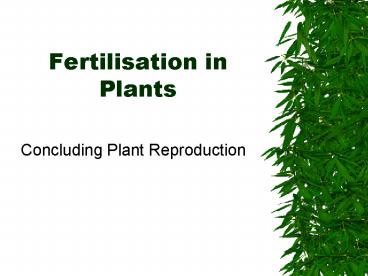Fertilisation in Plants - PowerPoint PPT Presentation
1 / 12
Title:
Fertilisation in Plants
Description:
Dioecious Plants. With dioecious plants each individual plant bears either male or ... Dioecious Plants. Paw-paw and holly are examples of dioecious plants. ... – PowerPoint PPT presentation
Number of Views:172
Avg rating:3.0/5.0
Title: Fertilisation in Plants
1
Fertilisation in Plants
- Concluding Plant Reproduction
2
Plant fertilisation
- When pollen sticks to the stigma it absorbs water
and starts to germinate - A pollen tube will grow out of the grain and
through the style towards the ovary
3
Plant fertilisation
- The pollen tube nucleus remains close to the tip
of the tube. - Digestive enzymes are secreted from the tube.
- The tube is attracted by chemicals given out by
the ovary.
4
Plant fertilisation
- As the tube grows the generative nucleus divides
by mitosis to form two haploid male gametes.
5
Plant fertilisation
- The pollen tube enters the ovule through the
micropyle. - Once inside the ovule the tube nucleus
degenerates and the male gametes enter the embryo
sac
6
Plant fertilisation
- One of the male gametes fuses with the female
gamete forming a diploid zygote. - In plants a double fertilisation takes place as
the other male gamete fuses with the diploid
nucleus in the centre of the embryo sac forming a
triploid nucleus called the endosperm nucleus.
7
Outbreeding mechanisms
- How plants prevent self-fertilisation
8
Protandry
- Most flowers use this mechanisms, e.g. rose-bay
willowherb - The stamens ripen before the stigma is receptive
to pollen. - So pollen is gone by the time stigma is ready.
9
Protogyny
- More unusual than protandry e.g. the bluebell
- The stigma ripens before the anthers.
- By the time the anthers shed their pollen the
stigma is no longer receptive to it.
10
(No Transcript)
11
Dioecious Plants
- With dioecious plants each individual plant bears
either male or female flowers, but never both.
12
Dioecious Plants
- Paw-paw and holly are examples of dioecious
plants. - Clearly self-pollination is impossible!































